Central Hall (1869)
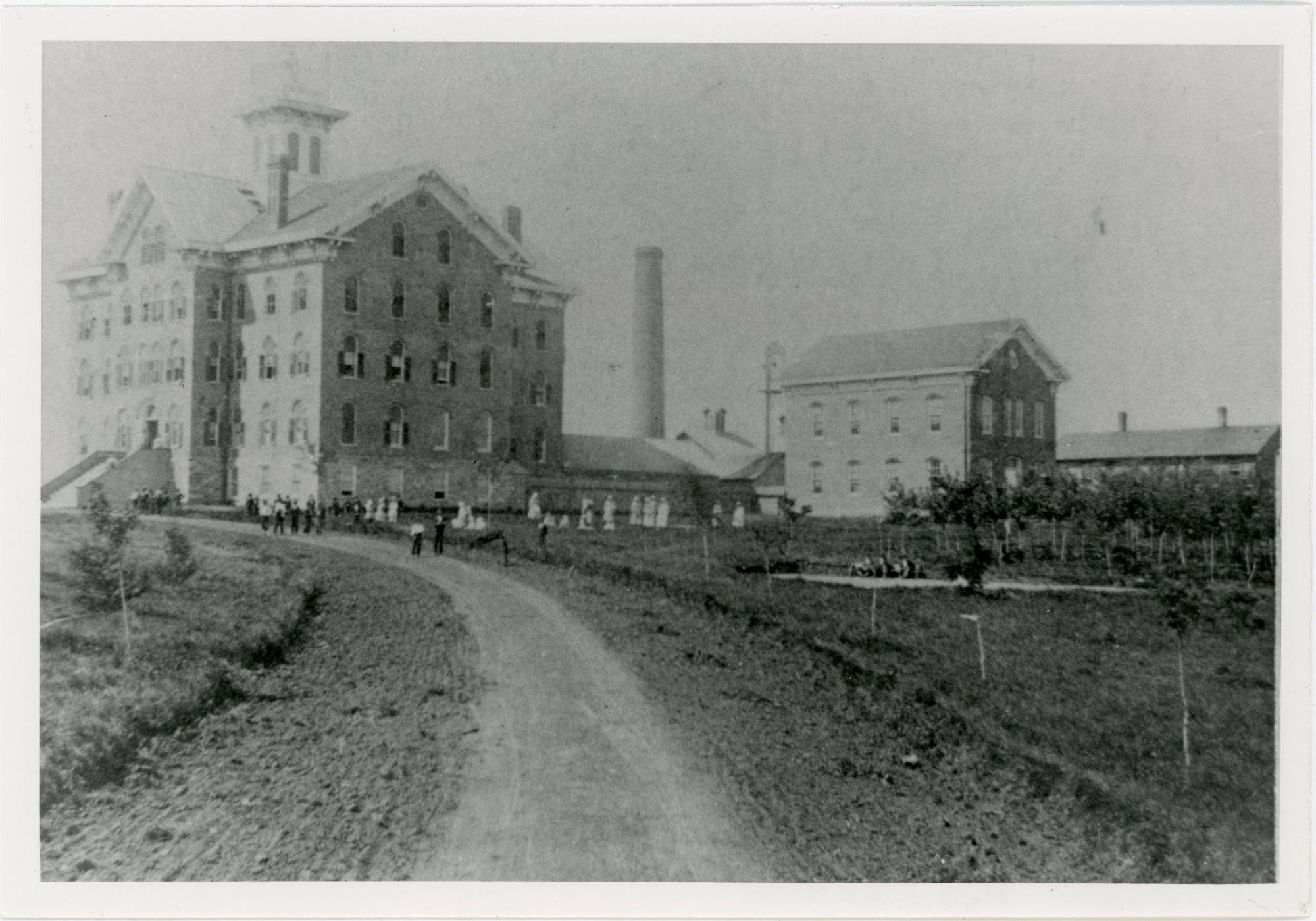
Content Warning: this article mentions suicide
When the first classes were held at the Iowa State Normal School on September 6, 1876, the building which would later become known as Central Hall was the only classroom building on campus. It stood approximately where the Maucker Union Expansion is located today. Central Hall had been built in 1869 as one of Iowa's Soldiers' Orphans' Homes to house children orphaned by the Civil War. The Iowa General Assembly appropriated $25,000 for the building; private subscriptions brought an additional $15,000; and the city of Cedar Falls donated forty acres of open land, which it had purchased for $25 per acre.
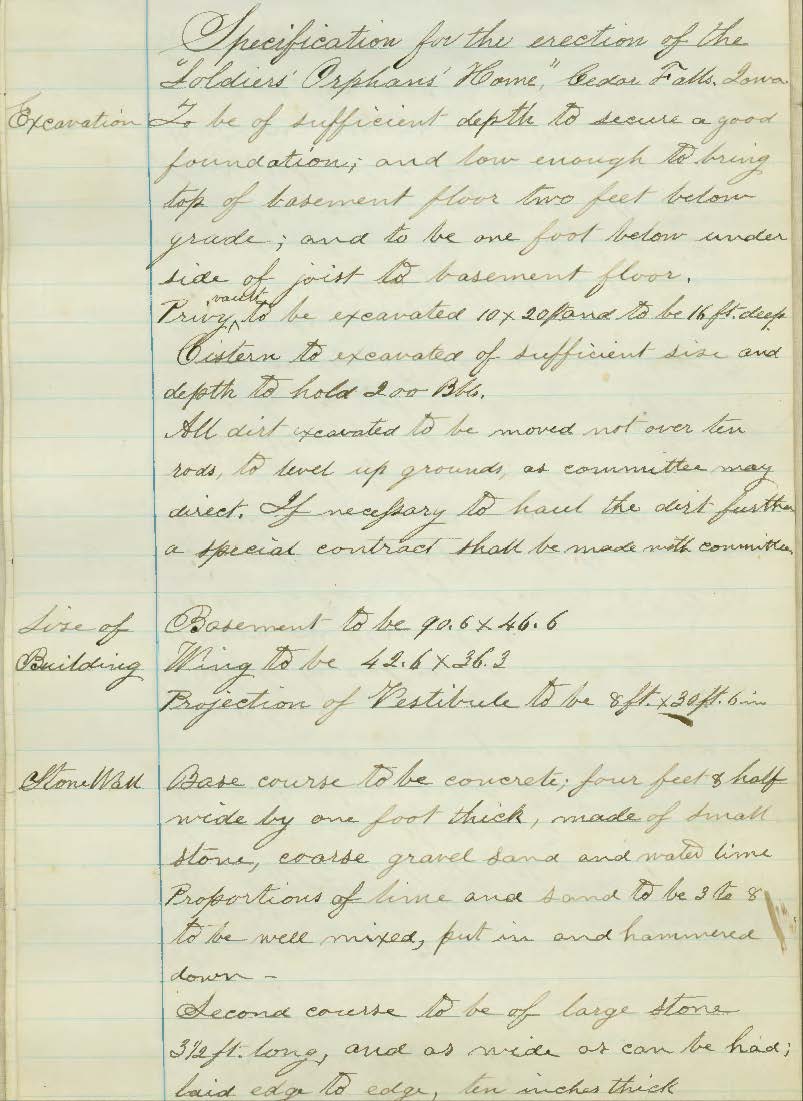
The tall building, standing alone on a prairie hilltop, must have been an impressive sight. In those days, the land was open, except for an occasional farmhouse, to the east, south, and west. Even on the north, toward the town of Cedar Falls, the land was open at least as far as 12th Street. Because of an epidemic of typhoid fever in their temporary quarters in an old hotel at Fourth and Main Streets, the orphans began to move into the still incomplete building on October 11, 1869. Those who could walk to the building, did so. Those who could not walk, road in a wagon. There were no windows or doors on the new building. The floors were covered with plaster from the newly-plastered walls. Water had to be hauled to the building because the well was not yet finished. But the building, when completed, provided a relatively comfortable home for hundreds of orphans over the next seven years.
As the years passed, the children grew up and left the Home. In 1876, when the state consolidated services in the Orphans' Home in Davenport, the Cedar Falls Home closed. The state was left with the prospect of a vacant building. Following heated debate and close votes, the General Assembly approved funds to start a state school for the training of teachers in the former Orphans' Home in Cedar Falls.
When the old Orphans' Home was the only significant building on the Normal School campus, it was usually referred to simply as the Normal School Building or the Building. After a new structure, later known as Gilchrist Hall, was built just south of the original Home building in 1882, the older building became known as North Hall.
As the campus developed further to the north, south, and west after the turn of the century, the original Normal School building began to be called Central Hall or Old Central.
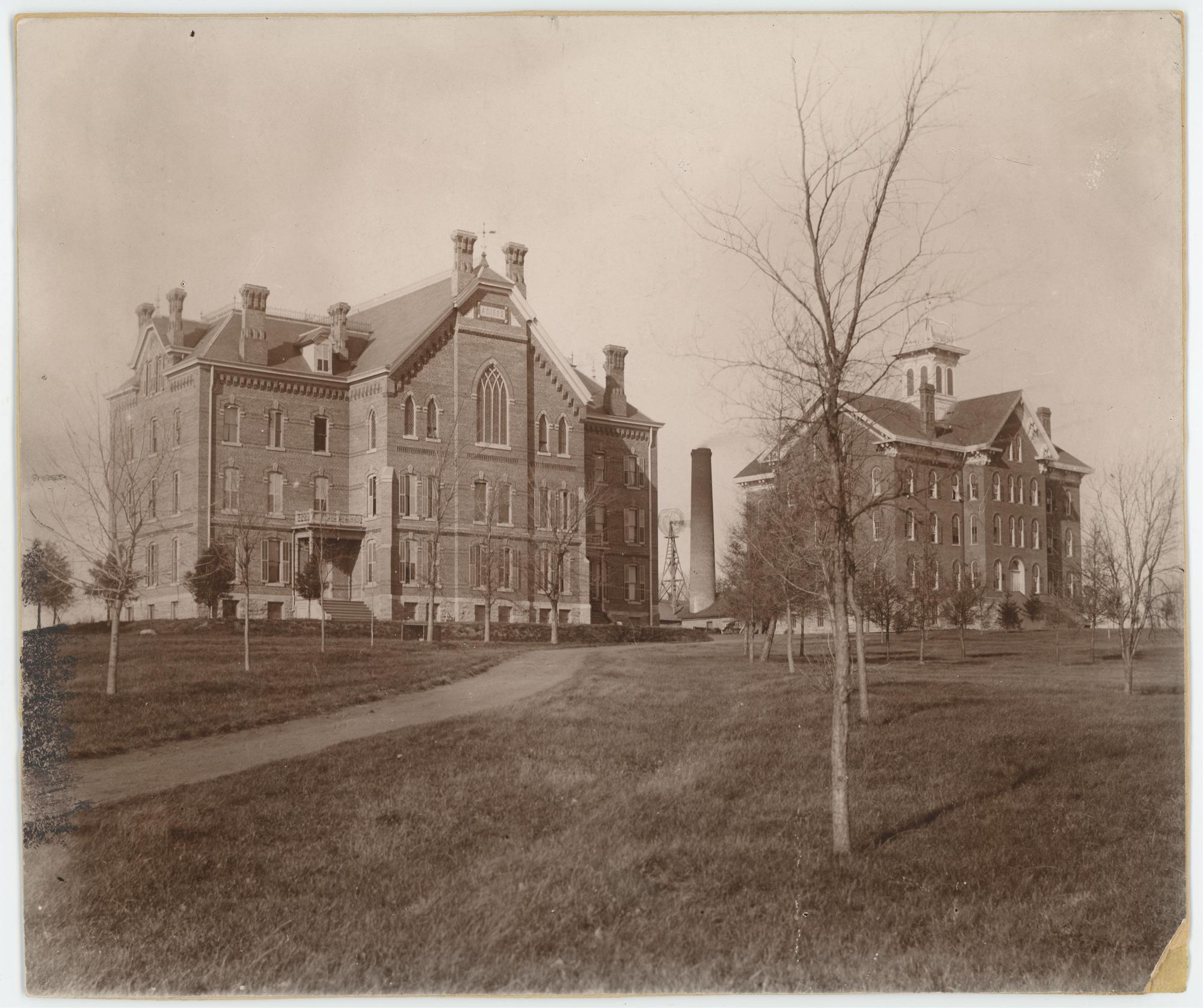
In the earliest years of the new normal school, nearly all of the school's activities took place in this four-level brick and limestone building. Students paid $2.65 per week for room and board. The basement of Central Hall contained the dining room. The first floor rooms were remodeled into offices and classrooms. The second and third floors were used as dormitories. During the school's first year, 1876-1877, women lived on the second floor, and women and men, carefully segregated and closely supervised, lived on the third floor. In 1877, the men moved out of Central Hall to a small outbuilding, which had been used during the Orphans' Home era as a chapel and office. Later, several classrooms were created on the second floor of Central Hall simply by removing partitions in the dormitory.
Women's dormitory facilities then occupied the remaining part of the second floor and the entire third floor. The building had a bell, housed in an ornate cupola, which signaled activities such as meals, class change times, and lights out. Students would occasionally climb up through the attic and into the bell tower for what must have been a truly spectacular view of the surrounding countryside.
Living and going to school in Central Hall was initially a primitive affair, at least by modern standards. The Orphans' Home administration had taken just about all of its equipment when it moved to Davenport. This was probably not a great loss since most of their educational equipment was suited more for younger children than for an institution aspiring to provide higher education. The General Assembly had provided little to take its place. Sections in the building were partitioned into dormitory space, with windows in only a few of the small bedrooms. Kerosene lamps provided light. A steam plant, maintained by campus engineer Alexander Martz, provided heat.

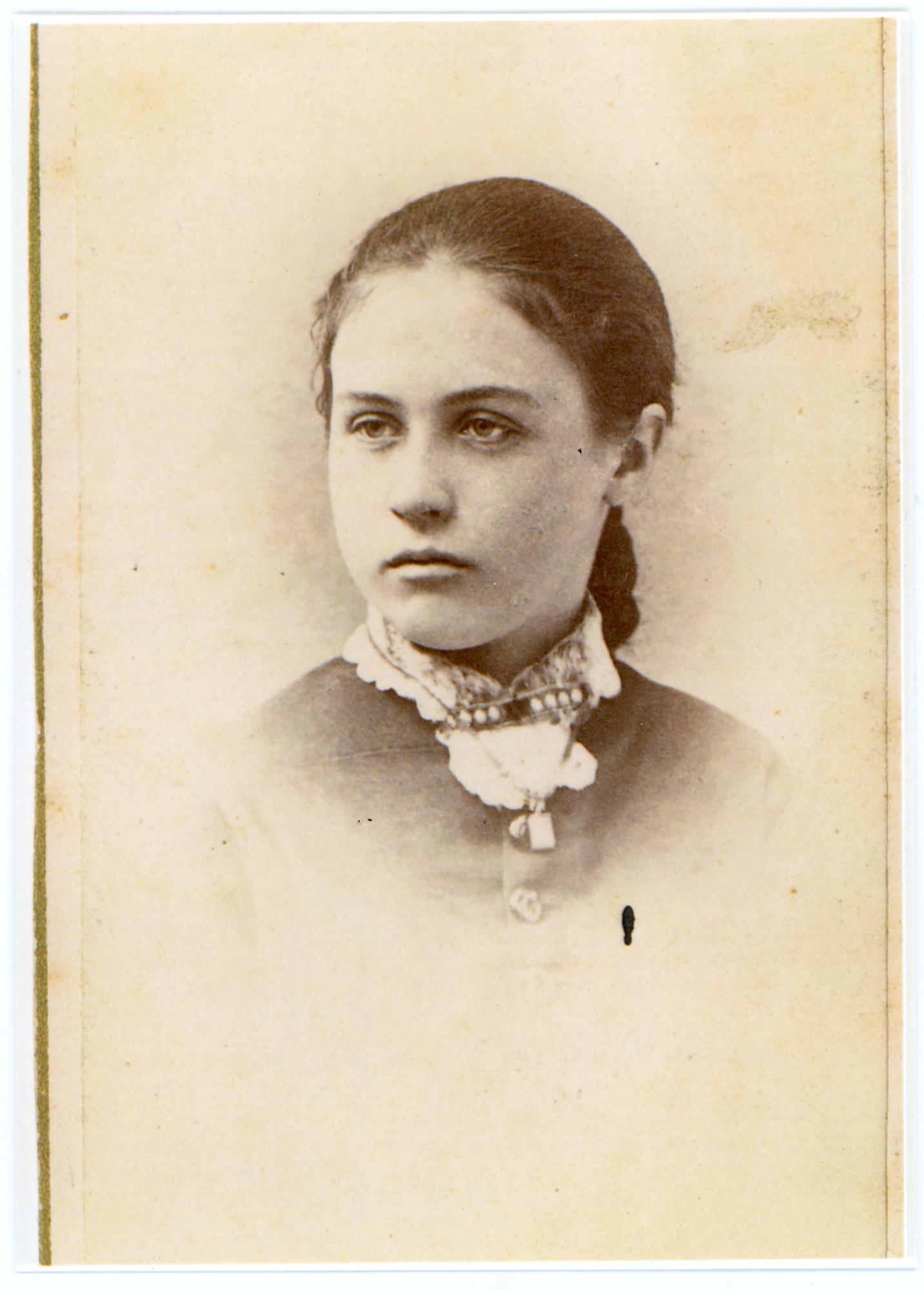
There was running water, but it was limited to a few taps in the building. Maude Gilchrist, daughter of Principal James Cleland Gilchrist, wrote about the water system: "We drew a pitcher of cold water from the big pipe, then let the steam from a nearby pipe bubble into the pitcher . . . ."
Principal Gilchrist's son Fred wrote about the rudimentary educational equipment. He said that the school "had blackboards and chalk and nothing else but bare walls and a few school seats . . . the pupil could look at the picture in the textbook and at a few diagrams on the blackboard and that was all there was to it." As for a library, "There was no library at all except some books which had been left behind by the orphans . . . ." Principal Gilchrist himself provided his own books to serve as the school's library in those early years.
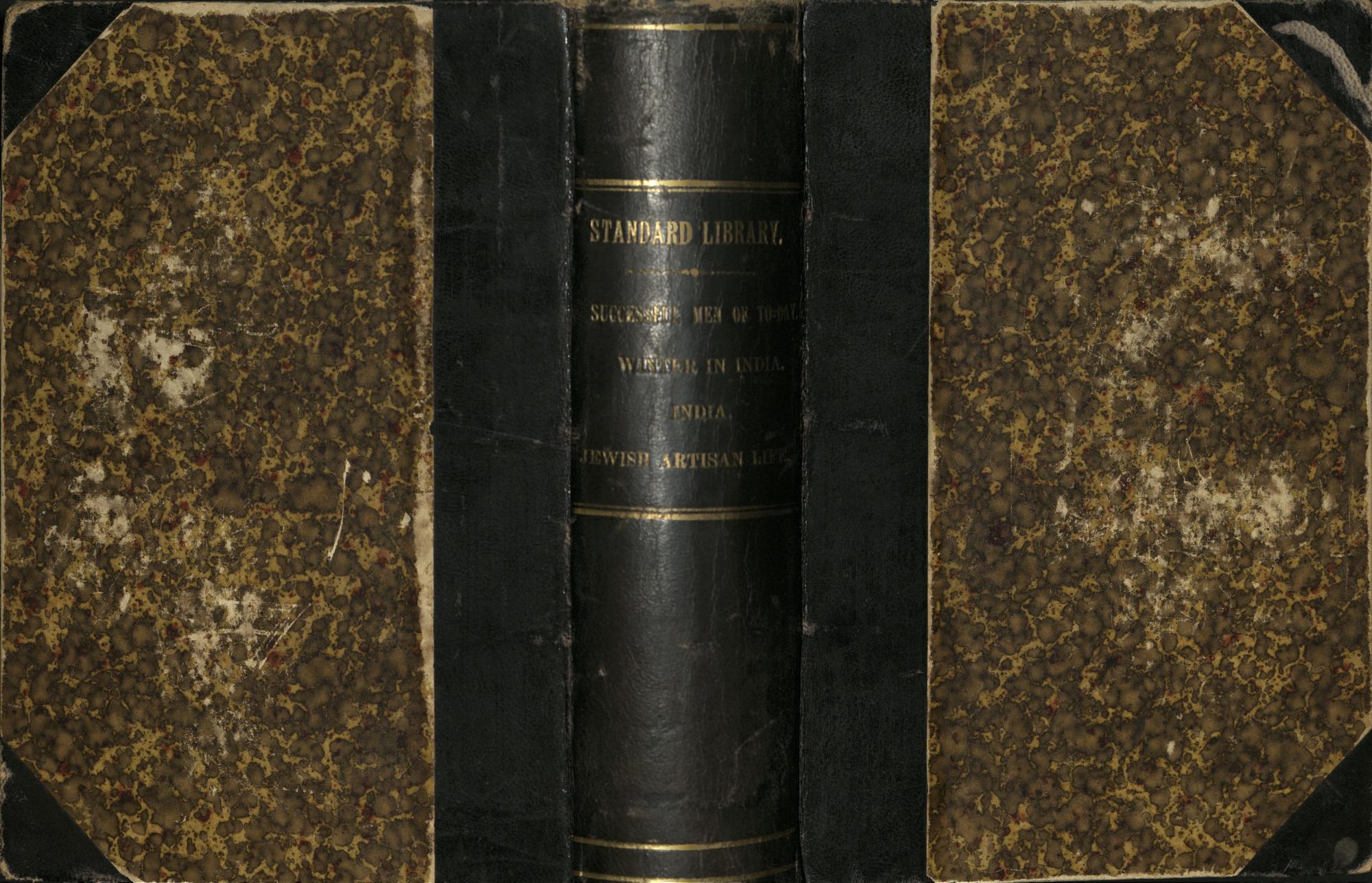
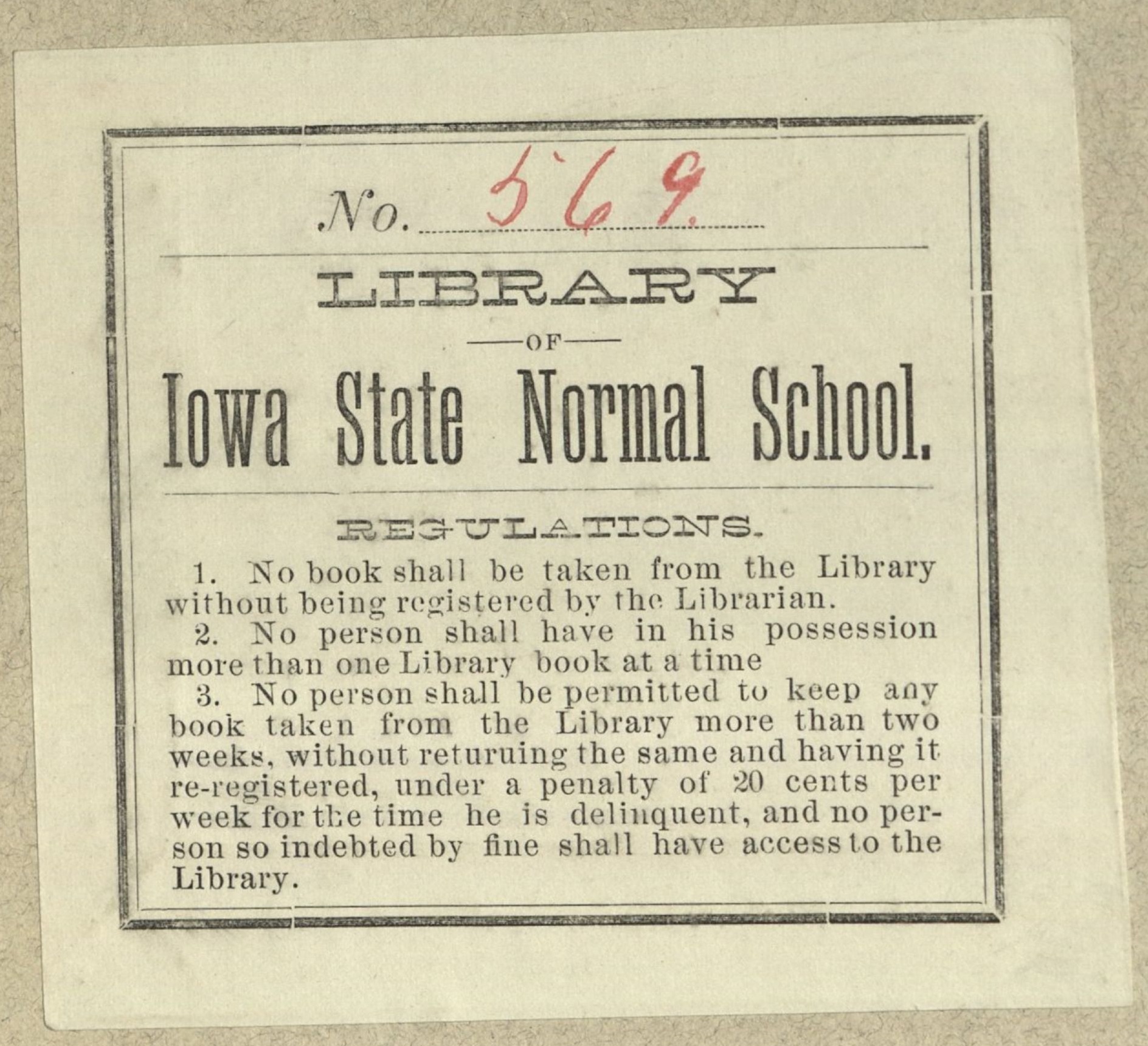

In the fall of 1878, Central Hall received its first significant improvements designed to make the building better suited for the school's mission. The campus newspaper, The Students' Offering, of December 1878, noted the following changes:
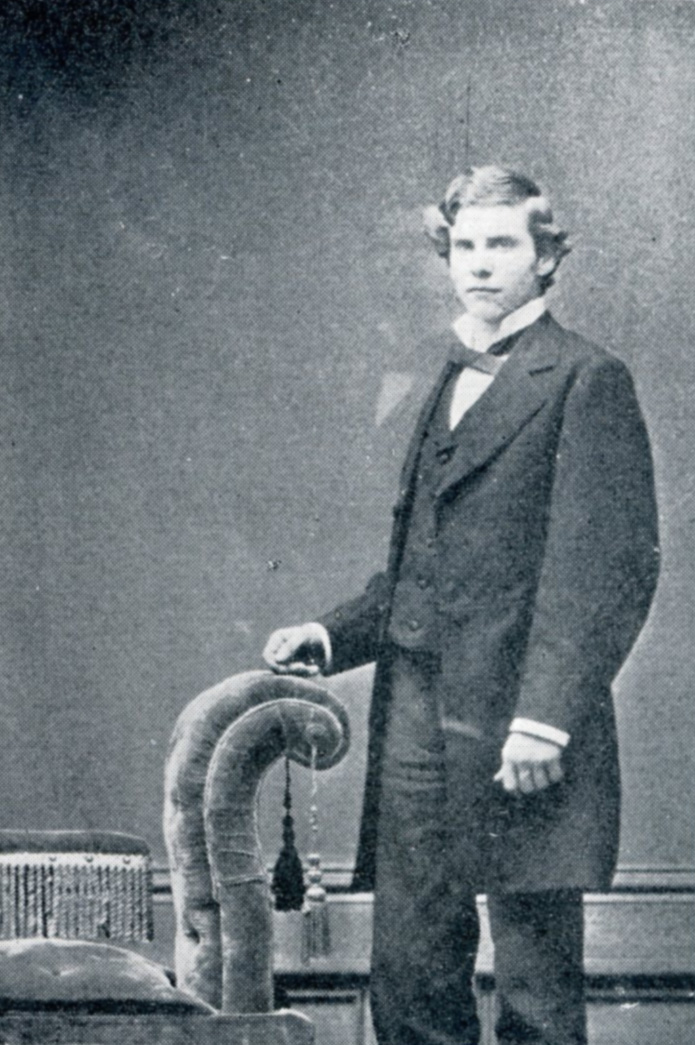
- partitions had been removed to enlarge the assembly room;
- additional blackboards had been installed;
- new floor coverings had been laid;
- the Principal's book collection had been moved to the parlor;
- walls were painted;
- the physics and chemistry laboratory had received apparatus valued at about $800.
The writer of that article concludes by saying, "Taking all together, we are very happily situated."
A very sad event occurred in Central Hall in December 1878. A former student of the Normal School, Rome O. Benton, came to campus for a visit on a Saturday evening. He talked with friends and had a meal with them. On Sunday he conducted himself normally. When it was time for afternoon church services at the school, he "invited a friend to step with him into the music room, shut the door behind him, declared his intention to die, drew a revolver, placed the muzzle in his right ear, fired, and fell dead." Mr. Benton had apparently become desperate over an unhappy romantic attachment. The event left the school in shock.
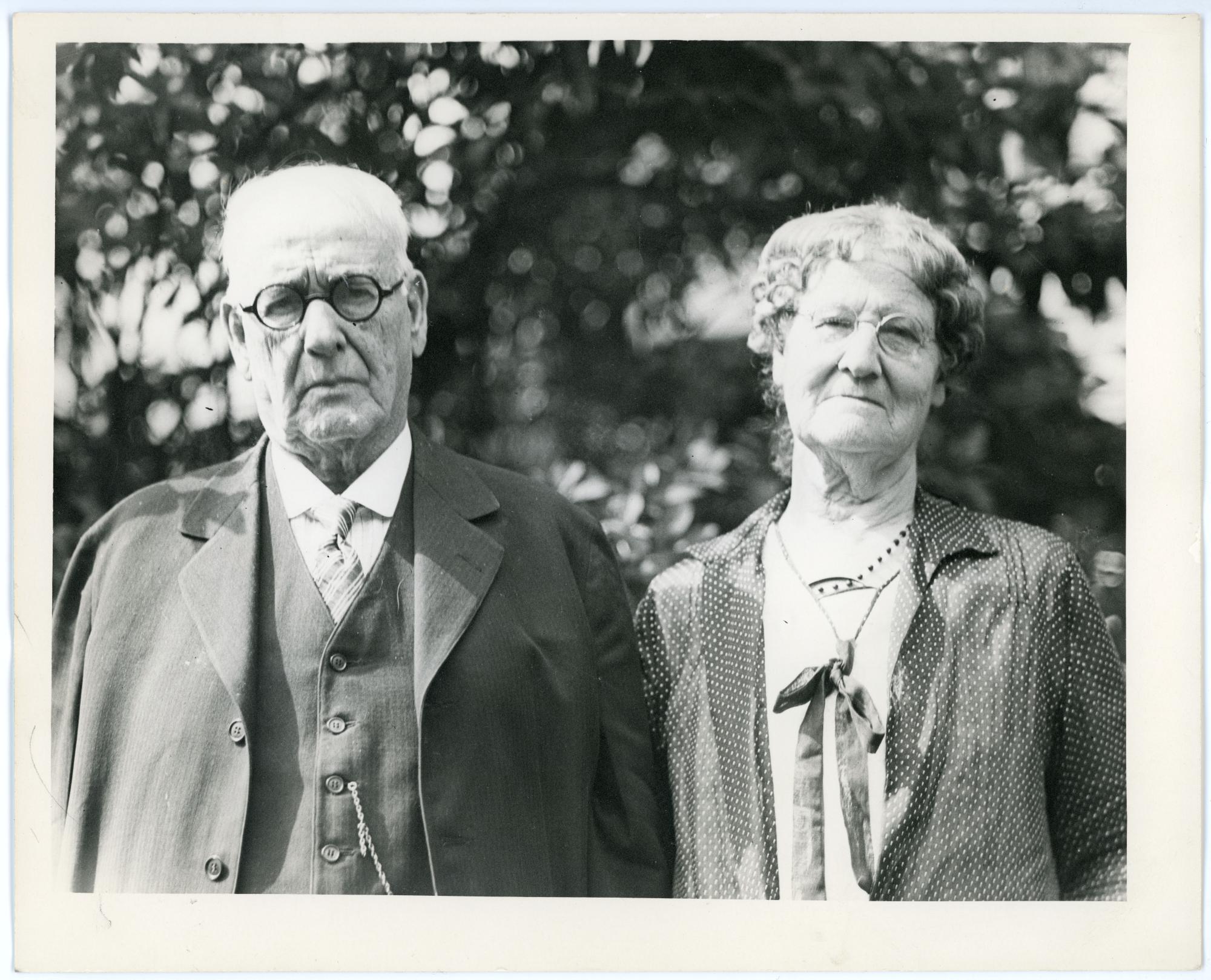
An additional classroom was carved out of the dormitory space on the second story in the fall of 1879, and the school acquired a new piano, which was placed in the music room. The old piano went to the assembly room. On April 18, 1880, a storm blew down one of the chimneys on Central Hall (see the image at the top of this essay). The bricks fell through the roof and down to the attic floor, but the partitions on the third story kept the bricks from falling further into the building. No one was injured. Damage to the chimney and to other campus property was estimated at $50-$60. One of the tall chimneys would again be blown down in a storm in 1892. During the summer of 1880, the state spent about $700 on new carpets, paint, wallpaper, and bookshelves. Principal Gilchrist's classroom was outfitted with new seats, as well. During the fall of 1880, the parlor was converted into a library and reading room, with a student librarian in charge of the newly classified and catalogued collection. Some of these improvements were in place when Professor David Sands Wright married one of his students, Eliza Rawstern, on the evening of her graduation from the Normal School, June 24, 1880.
Central Hall witnessed the campus introduction of late nineteenth-century technology. During the school year of 1878-1879, students gathered to see a new phonographic recording machine. As alumna Ella Rich Rundles recalled over forty years later, Professor William N. Hull spoke into the recording device so that his voice would be preserved on the foil medium.

She said, "It went through all right, but sounded more like the squeaking of a mouse than the voice of our rhetoric teacher. However, it could be distinctly heard all over the room--a wonderful invention." Another new technological advance came to campus in 1881 when a telephone was installed in Central Hall. This was almost certainly the first telephone on campus. It connected to both Waterloo and Cedar Falls. A writer in The Students' Offering noted that the telephone "saves many weary tramps downtown for 'that little thing that I forgot.'" One wonders what access students had to the school's single telephone.
In 1892 the General Assembly appropriated $5000 for repairs to Central Hall. This was meant to soften the blow of delaying funding for a badly needed new building. The money would be used to refit Central Hall with additional classrooms. Enrollment had been growing to the extent that the Board decided to discontinue the school's boarding department, housed primarily in Central Hall, and to remodel that space for educational purposes. There was also consideration of building a bridge between Central Hall and Gilchrist Hall. With the discontinuation of the boarding department, and the consequent elimination of the basement dining room, the alumni held their annual banquet in Central Hall for the last time in 1892.
By September 1892, Central Hall looked different. The basement had been fitted up as an armory and drill room for the Student Battalion. Cadets had easy access to that area via the west door. There was also a chemical laboratory and a storage area for athletic equipment on that level. Women's calisthenics classes began to meet in the armory that fall, but moved upstairs due to high enrollments. The parlor and an adjacent room on the first floor had been combined into a large classroom. There were also two large coatrooms and a book room on that level. The second story included two classrooms as well as space for preparatory and training school students. There had been no changes on the third level, though there were plans to build literary society halls. Society bulletin boards remained in the vestibule of Central Hall. Infrastructure improvements took place just north of Central Hall in 1892 when a new cinder roadway was built over the former croquet grounds in that area. Late that fall a new elevated walkway between Central Hall and Gilchrist Hall was under construction. The Normal Eyte commented that "This is a most desirable addition to Normal architecture that will be most highly appreciated by all students. Now let the winds howl and the rains descend! What care we!" In the days of heavy, bulky clothing, an indoor passage must have been most welcome. It also saved on wear and tear to the facilities. The bridge was completed later that school year. While the bridge had the potential to increase the efficiency of passage from building to building, students would occasionally, and intentionally, cause a traffic jam on the bridge to delay their arrival at their next class.
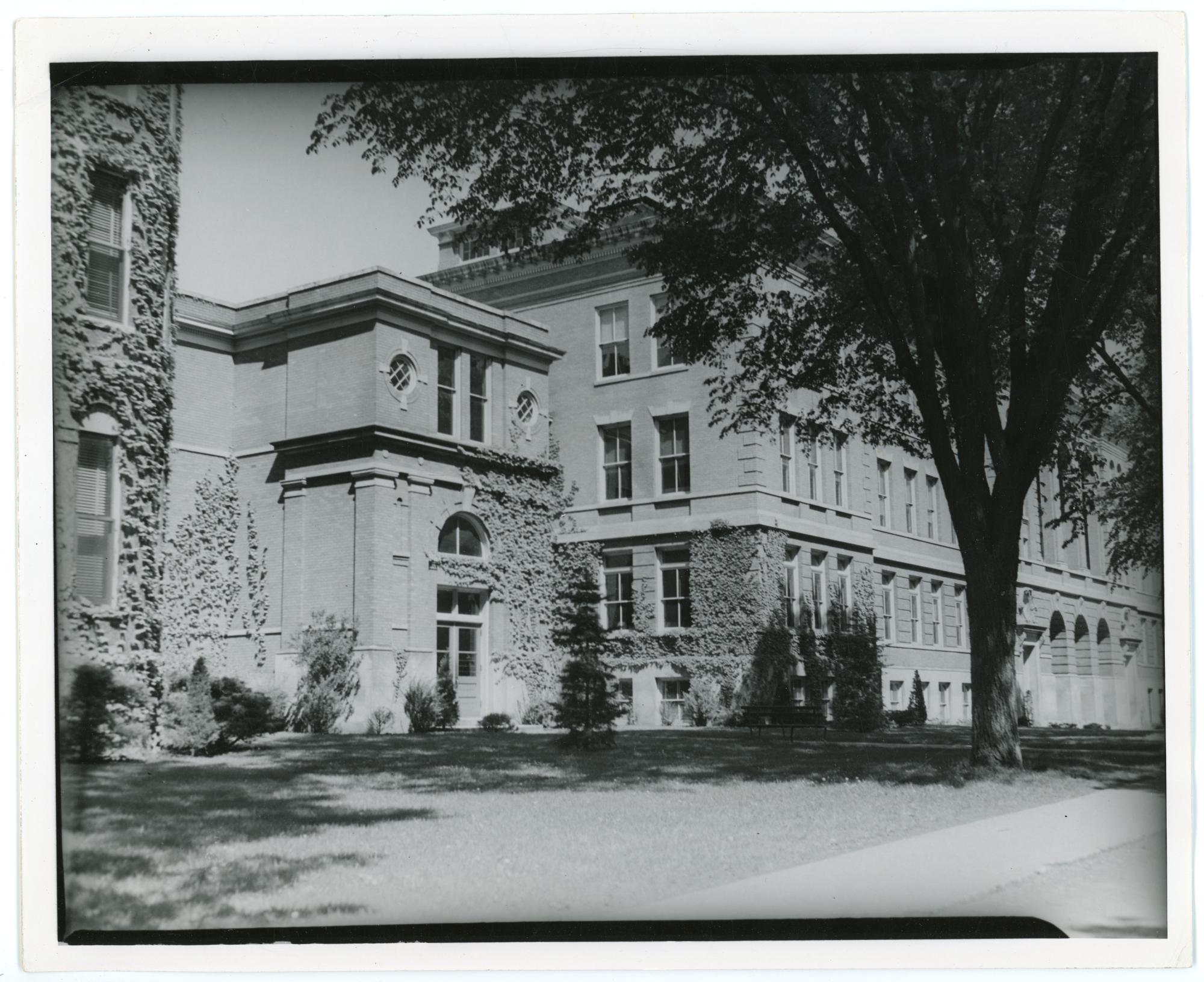
In the fall of 1892, students also began to agitate for "bathrooms" in Central Hall. In this case, the word "bathroom" should be taken literally: that is, facilities in which students could take a bath. Bathrooms were ultimately built under the auspices of the Young Men's Christian Association. In the fall of 1893 the preparatory department moved into the third floor of Central Hall, even though the literary societies were still searching for rooms of their own, possibly on that floor. The Board proved willing to provide the third story to the societies if the societies were willing to undertake the cost of remodeling. The societies met at Commencement in 1894 and drew up recommendation to divide the third story into three large rooms, with a budget of about $1200 for construction, decoration, and furnishings.
In the fall of 1895, the long set of exterior steps on the east side of Central Hall, often icy and dangerous in the winter, were removed; the doorway was lowered; and a large window was inserted above the door, which was lowered to ground level. Interior stairs substituted for the exterior steps. This resulted in more light inside the main hallway. Also, the drive on the east side of campus was moved to the rear of the buildings to provide more green space in front of the buildings. When space in the new Administration Building began to open up in January 1896, the second and third floors of Central Hall were devoted entirely to the Training Department, a precursor of the Laboratory School. During the summer of 1896, the third story received new flooring and furniture. During the next summer much of the interior of Central Hall was painted and papered so that the Normal Eyte could say, "At no time during the past ten years has the building been in as good repair throughout."
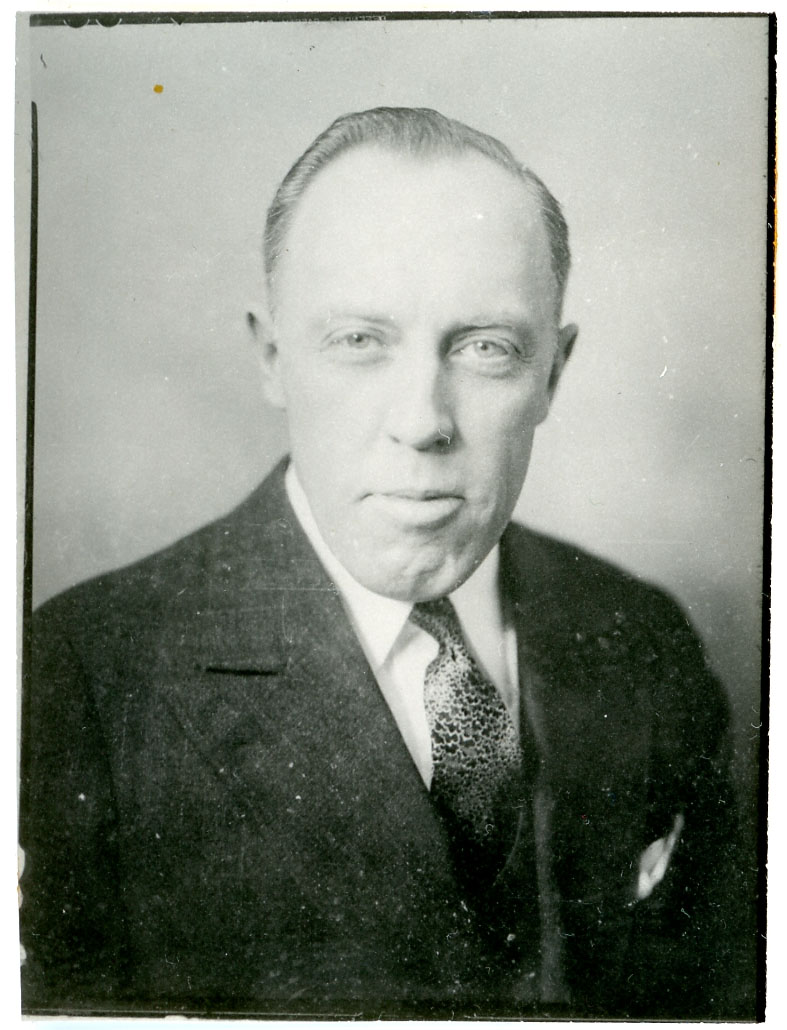
In early 1898, with enrollment continuing to grow, the men's coatroom was shifted from the first floor of Central Hall to the basement to make room for a new, enlarged women's coatroom. In 1901, during the construction of the Auditorium Building, now Lang Hall, a link, later known as the Crossroads, between the new building and the Administration Building was built. A corridor extending west from the Crossroads to Central Hall meant that all four of the school's major buildings were connected. Students could attend classes in any building without going outdoors.
Over its long history, Central Hall was used for many purposes. Modifications removed some its grace and beauty. For example, in 1905 the gables and the beautiful decorations atop the bell tower were removed. The bell itself continued to be used to announce the beginning and the end of each school day until at least 1926. Thereafter it would be rung only occasionally. On February 28, 1931, for example, a small group of students rang the bell to celebrate a basketball victory. They then escaped by running across the roof and down a fire escape. Later the bell would be used to announce Cut Day on campus.
Despite its age, Central Hall still served as an important classroom building for many years. If the number of articles in the student newspaper is any gauge, students seemed to have a special affection for the history of the building as the Orphans' Home and the starting point for the college.
When President Latham began his administration in 1928, one of his primary aims was to increase the efficiency of college operations. Consequently, he consolidated the locations of the various instructional departments, whose faculty and classrooms had been scattered across campus. The Commercial Department, which had been occupying a portion of the third floor of Central Hall, moved to the Administration Building, and the music faculty and classrooms moved into Central Hall. The YMCA, the campus supply office, and student club rooms occupied the basement. The YMCA operated a little convenience store in Central Hall, where students could buy candy and pop. The college outfitted a new band and orchestra practice room in the building. The room was arranged in tiers, with individual lighted music stands. It accommodated about sixty musicians. Professor Myron Russell, who directed the College Band, thought that the new facilities contributed to the improvement of the group.

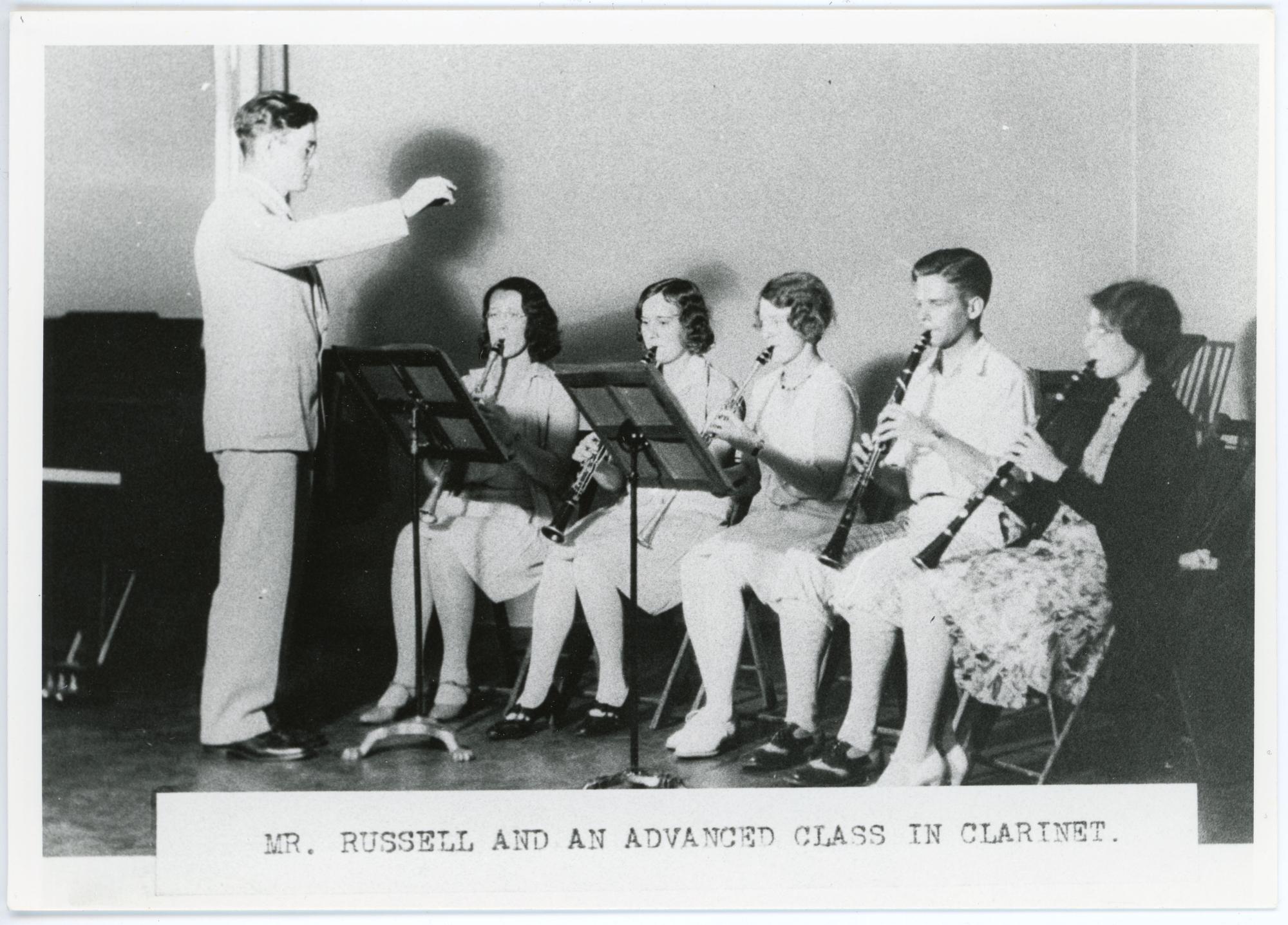
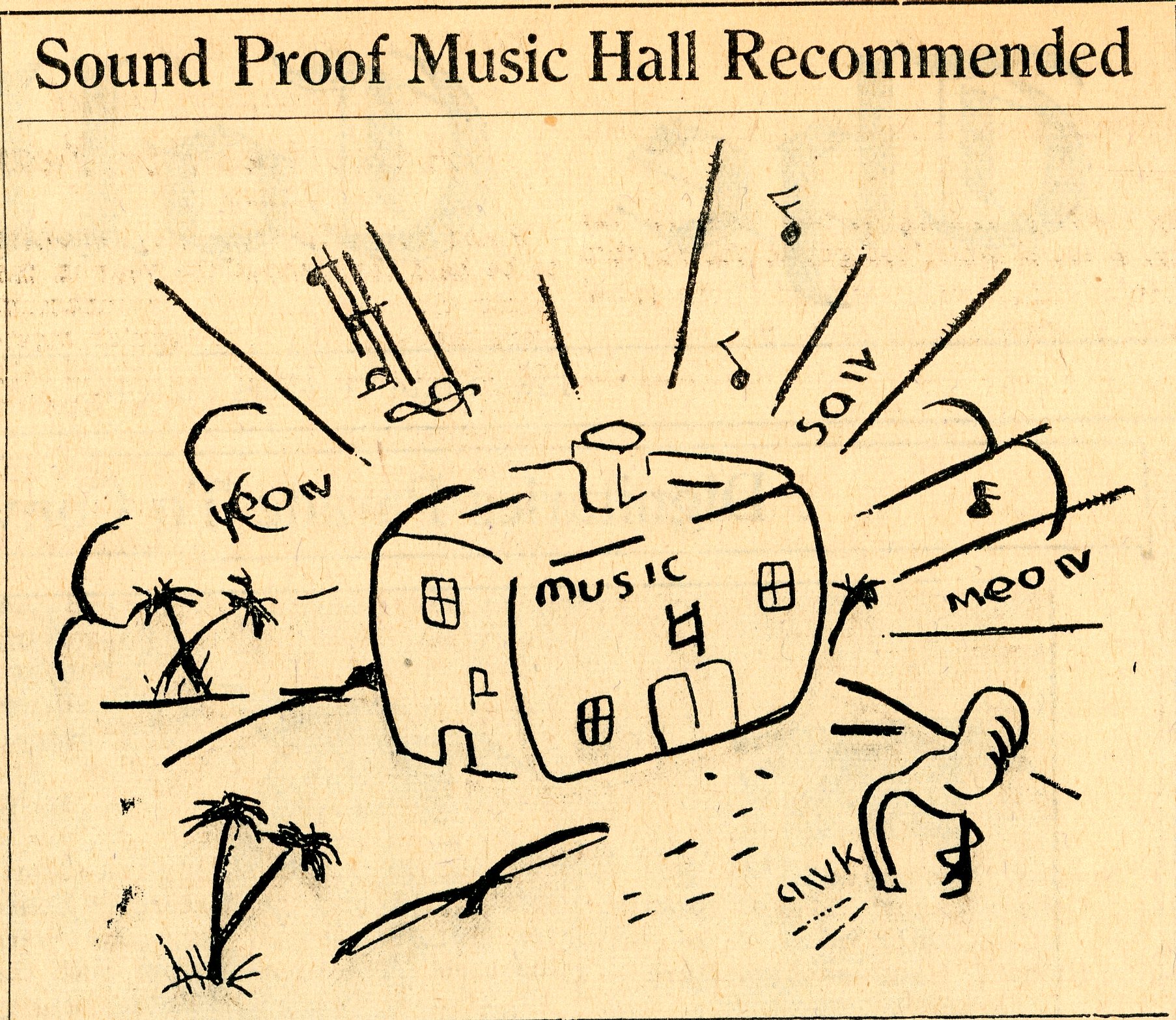
Central Hall underwent significant remodeling beginning in the summer of 1932. Some of the improvements were general, but others were designed specifically for the Music Department. New linoleum was installed in most of the building, and some of the stairways were reconstructed. Drinking fountains were installed on all floors. New gutters were added in May 1933. The department received a new music library with books, records, a phonograph, and sheet music. Music faculty received private offices.
In 1934, as another sign of President Latham's effort to make the school more collegiate and oriented toward scholarship, the Bureau of Research, under the direction of Professor Joseph B. Paul, was established on the second floor of Central Hall. The college Mimeograph Room moved to Central Hall in the summer of 1936.
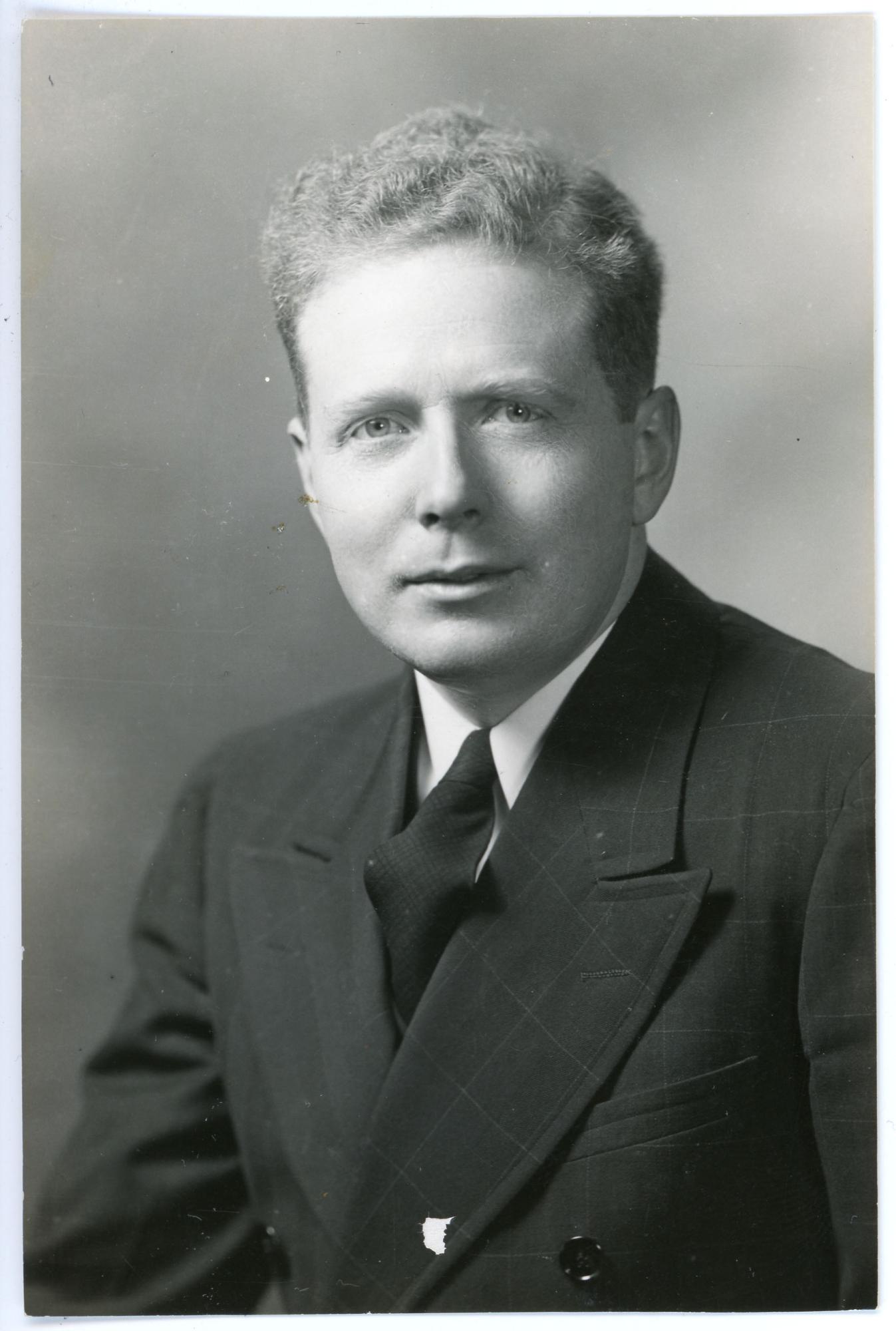
The Music Department became so closely identified with the building that students sometimes referred to Central Hall as the Music Building. Passing students and occupants of nearby buildings became accustomed to hearing both pleasant and discordant sounds coming from the practice rooms. One College Eye writer in 1937 said that he had trouble writing for newspaper deadlines while the sounds of piano, voice, organ, and clarinets rang in his ears.
In 1947 President Malcolm Price announced plans for the development of the campus. Those plans called for the replacement of the three oldest classroom buildings: Central Hall, Gilchrist Hall, and the Old Administration Building. But those were long range plans, or, perhaps at the time, just dreams. All three of those buildings managed to hang on for quite a few years. In 1953, Central Hall received a new roof to replace the old roof that had been damaged in a hailstorm that spring. Its outside trim was painted, too.
In the summer of 1956, Registrar Marshall Beard spoke to a Phi Delta Kappa meeting on the campus changes that he expected in coming years. Among those changes was the elimination of the three buildings noted by President Price a decade earlier.
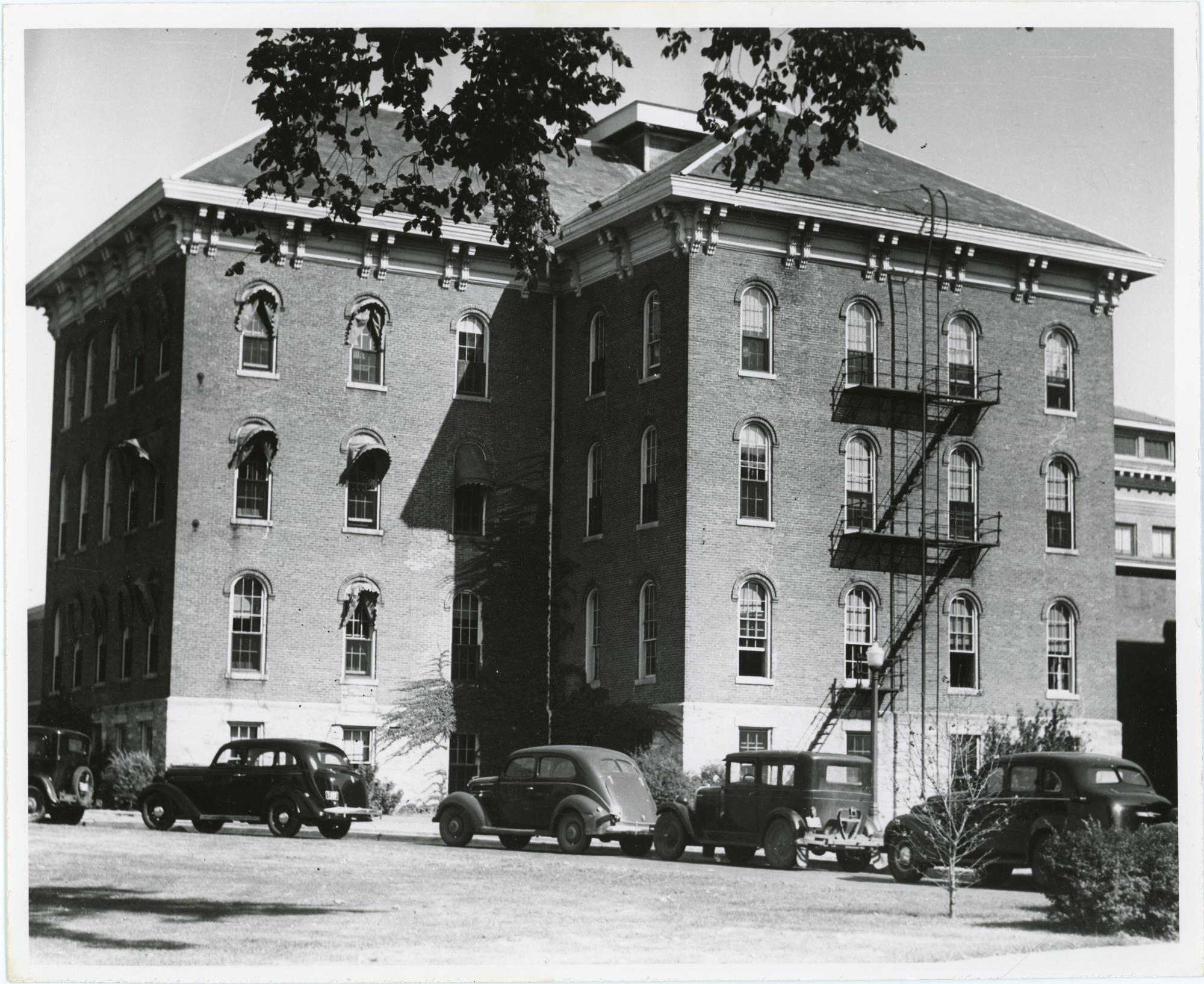
Those plans seemed to remain on track in 1959 when the General Assembly appropriated $2.57 million for new construction on campus. Included in the plans for that money was the construction of a new Music Building. An article in the Alumnus notes that Central Hall, where much of the Department of Music was located, is "Now obsolete and hazardous from the standpoint of fire, and even dangerous because of structural weakness . . . ." That certainly sounded serious.
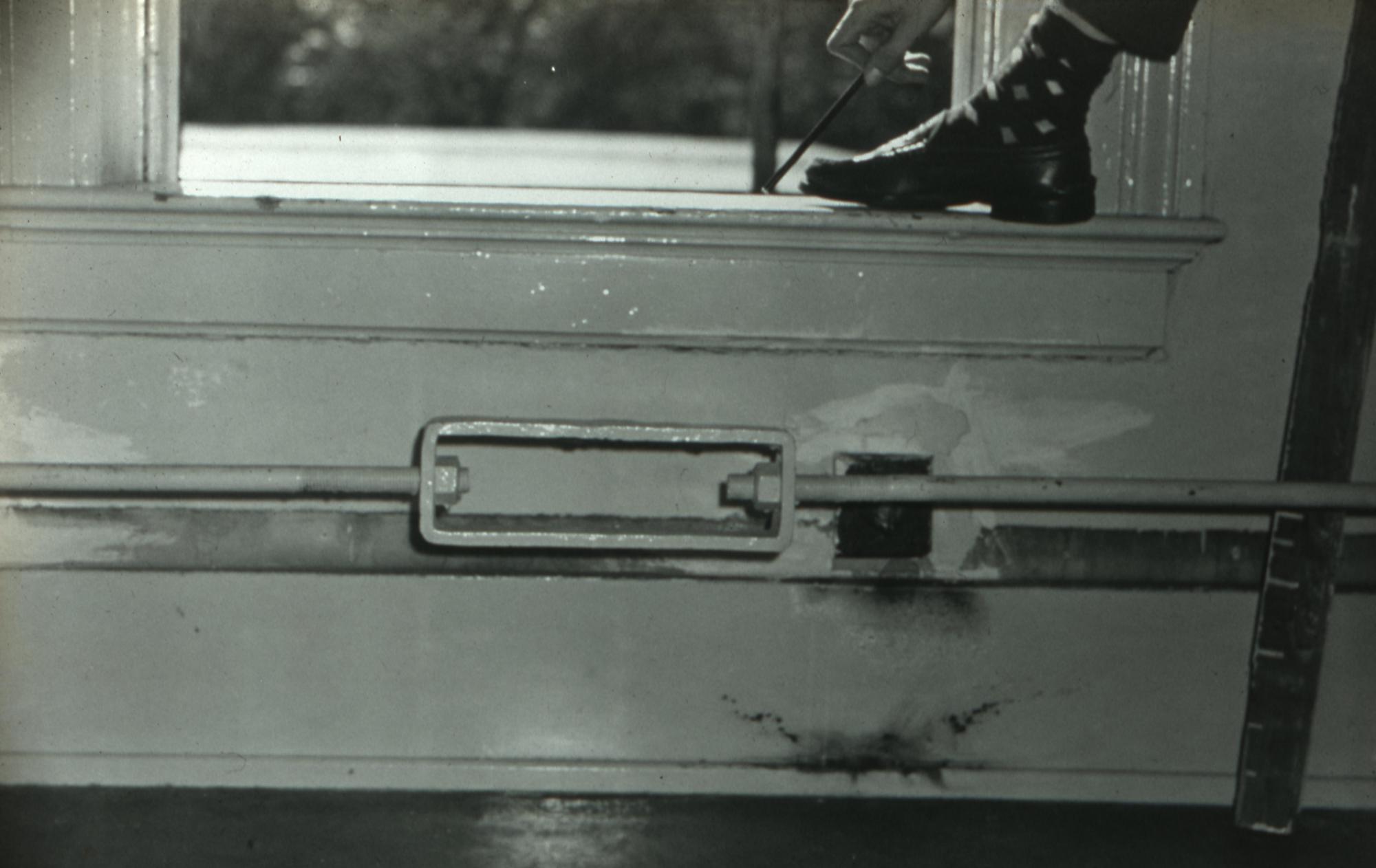
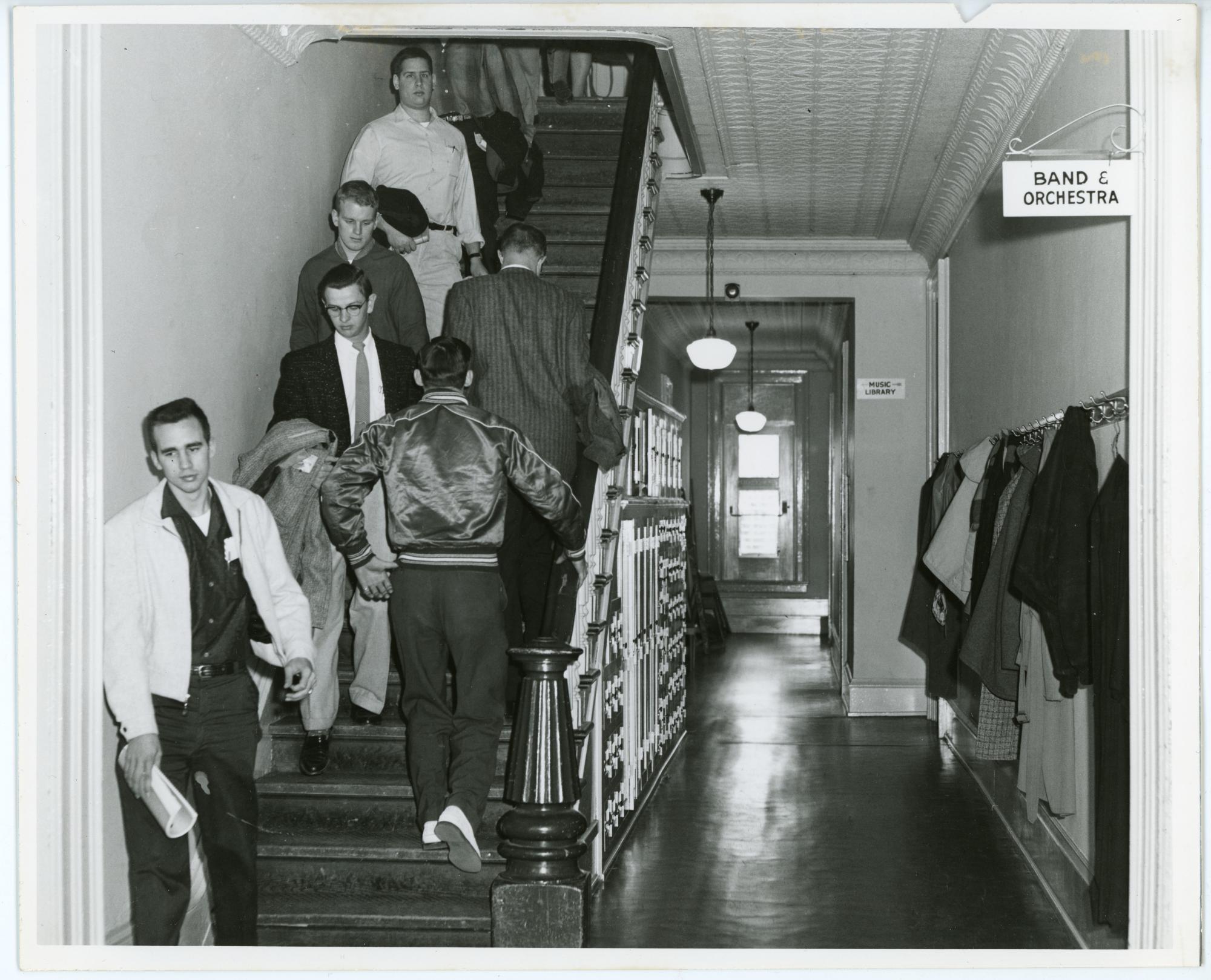
In 1962, when the Music Department moved out of Central Hall and into the Russell Hall, the top floor of Central Hall was closed. Officials cited narrow stairways among the hazards of the old building.
After the departure of the Music Department, Central Hall housed a few classrooms, the remedial reading clinic, the mimeograph office, and offices for sixteen faculty members in the Department of English Language and Literature. Dean of Instruction William Lang announced that as soon as space for these occupants could be found in other buildings, Central Hall would be demolished, perhaps in another ten years or so. Much of the grace, ornament, and beauty of Old Central had been lost by this time.
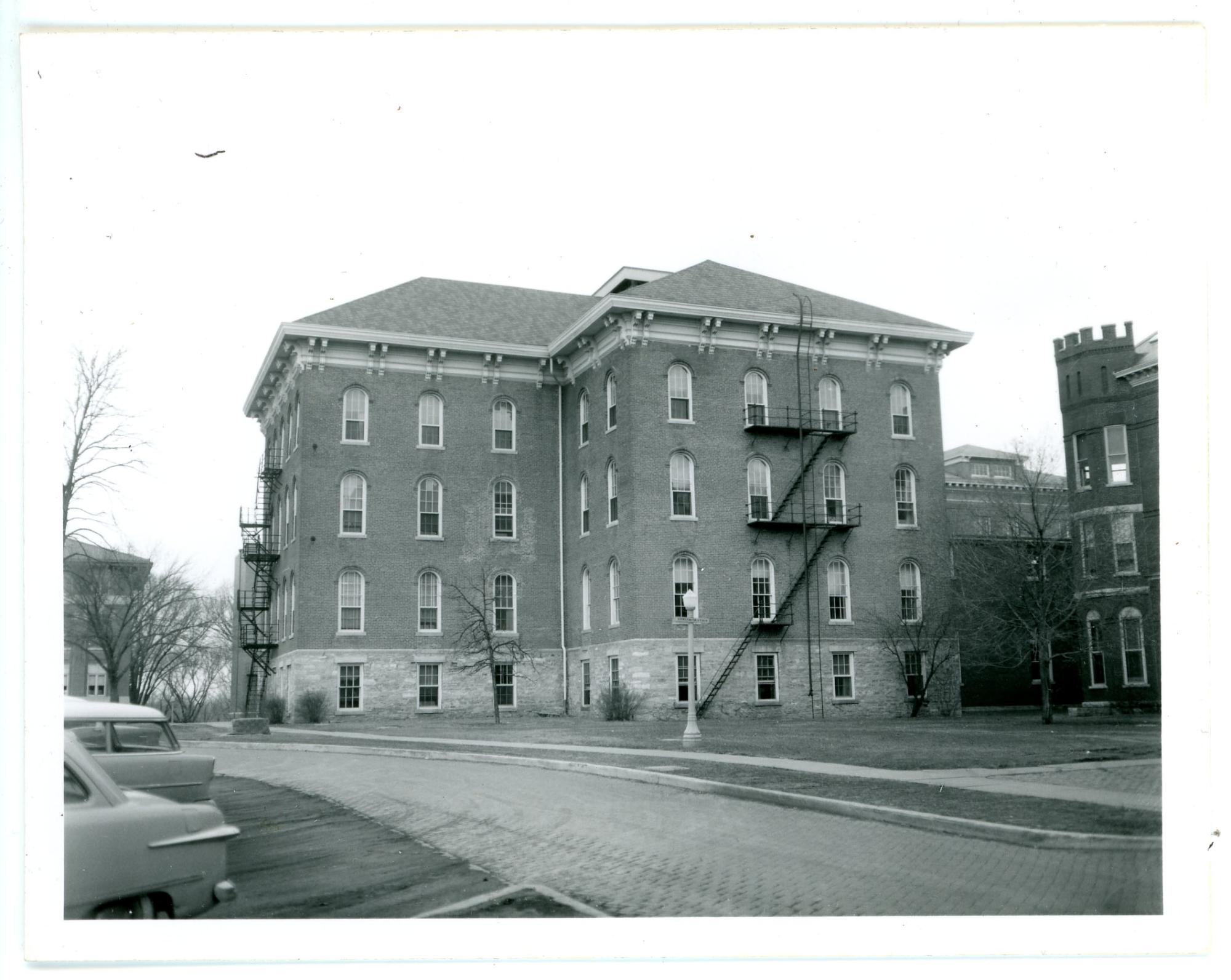
Central Hall burned on July 22, 1965, in a spectacular night fire determined later to have been caused by faulty wiring. College Eye Managing Editor Kent Speirs discovered the fire as he was leaving the newspaper office in Old Gilchrist Hall at 12:40 AM. He informed a campus security officer that he saw smoke coming out of a window. They entered Central Hall in an attempt to investigate, but were driven back by smoke and heat. They called the Cedar Falls Fire Department, who were later aided by the Waterloo and Dike Fire Departments. But the blaze could not be controlled. It spread from the first to the second story, then to the third story and the roof.
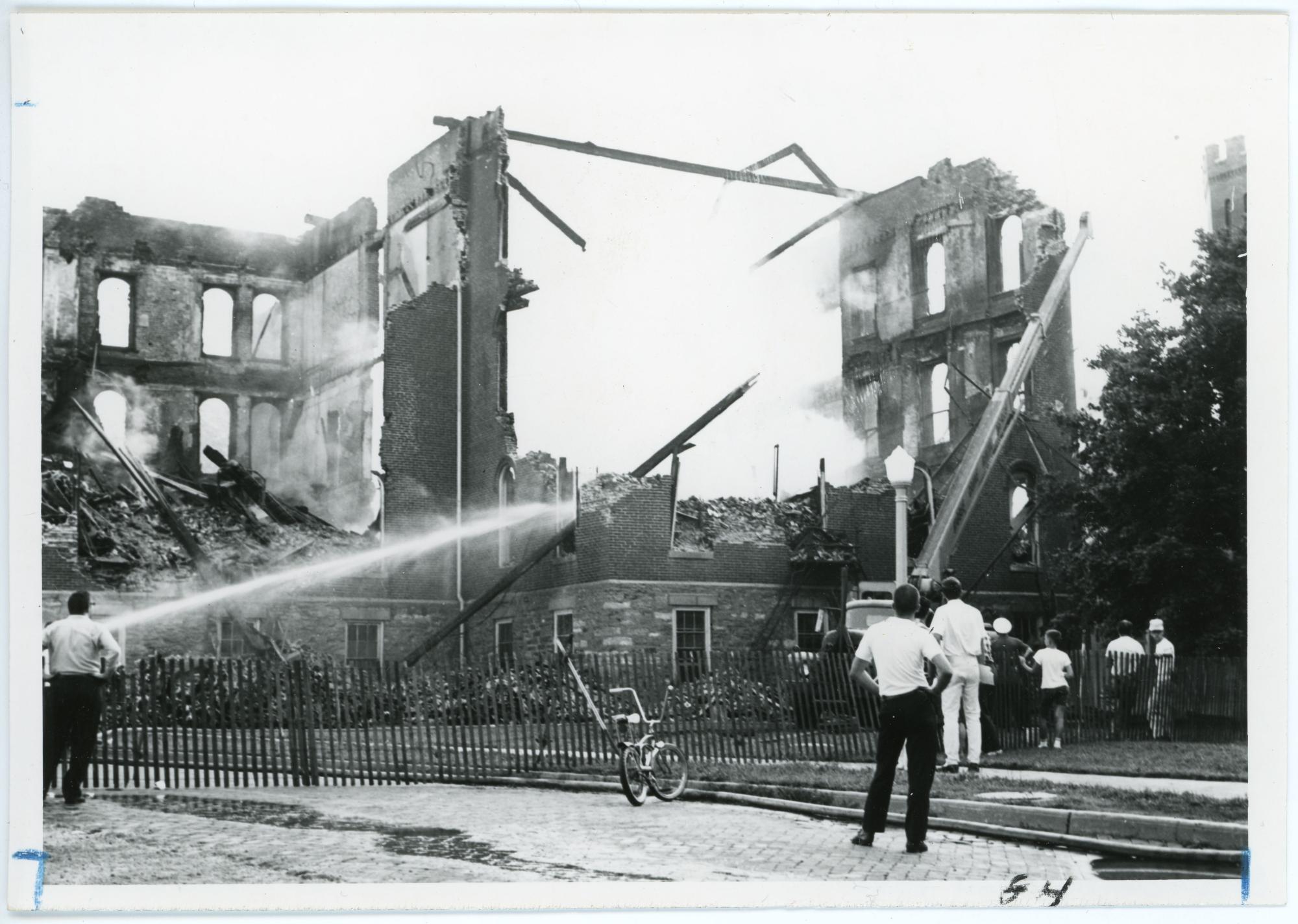
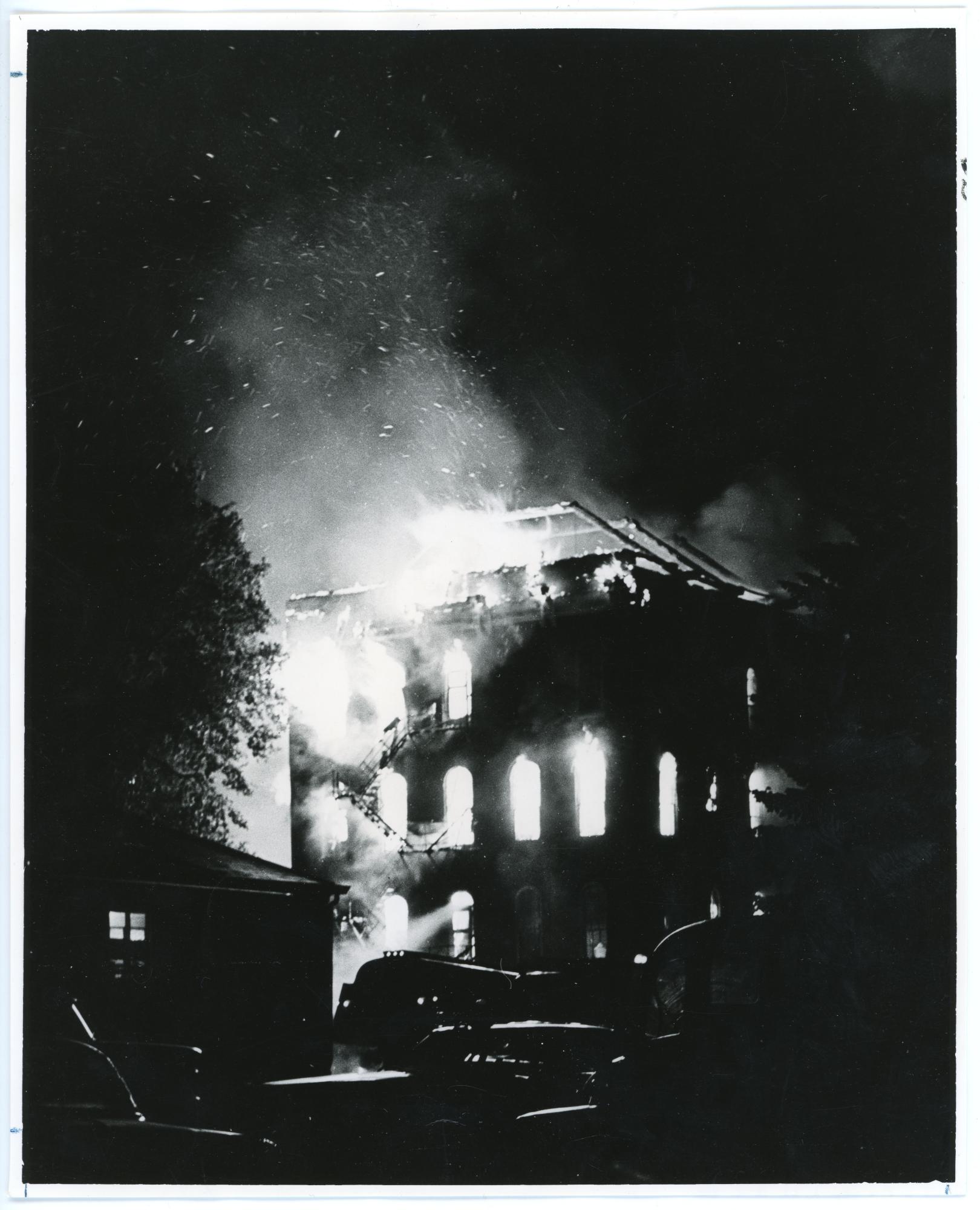
All firefighters could do was to keep the fire from spreading to other nearby buildings. By morning, the building was a total loss.
Many faculty members lost the contents of their offices--books, class notes, research material--in the fire. Professor Robert J. Ward, of the English faculty, lost his nearly completed doctoral dissertation. He had an early draft stored at home, but he said that it would likely take him a year to bring that version up to date.
Because firefighters feared that some of the remaining brick walls would collapse onto other buildings, a crane pushed the walls onto the smoldering pile of wreckage. Clean up of the site and repairs to the Crossroads continued for some months afterward.
The college was left with significant scheduling problems in the wake of the fire. Summer classes could be relocated easily enough. However, the fall semester presented a more difficult situation. The college had planned to use Central Hall classrooms heavily. In addition, plans called for thirty-four faculty offices in the old building. The Registrar re-scheduled most of the classes for Sabin Hall. Faculty members who had had their offices in Central Hall found themselves scattered in several locations.
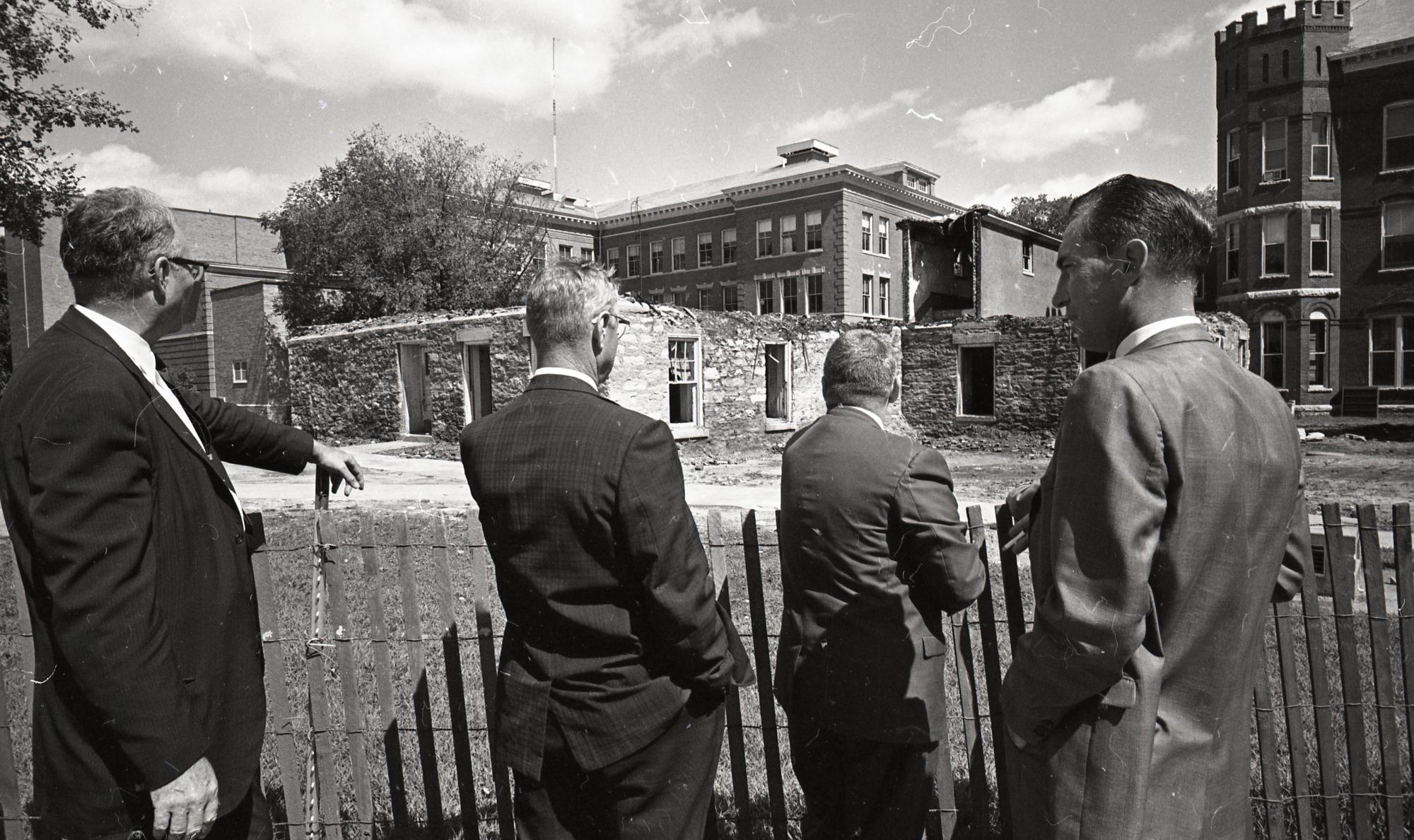
The fire in Central Hall had other implications. Rather than replacing the building, the Regents decided to fund an addition to the newly-completed Administration Building, now known as Gilchrist Hall. This $631,000 project added 27,504 square feet to the east side of the Administration Building.

In addition, the old Reading Room in Seerley Hall was converted into classrooms. Seerley Hall had served as the campus library until the Rod Library opened in 1964.
The State Fire Marshall visited campus on an inspection tour in the summer of 1965 and left a long list of hazards that needed to be corrected. Campus officials had always taken the Fire Marshall's recommendations seriously, but, with the Central Hall fire such a recent memory, they made special efforts to improve wiring, clean out attics and basements, and eliminate wooden blocks used to prop doors open. The report also helped the administration to make a stronger case that the campus needed new, safer facilities.
Compiled by Library Assistant Susan Witthoft; edited by University Archivist Gerald L. Peterson, July 1996; substantially revised by Gerald L. Peterson, with scanning by David Glime, August 2006; last updated, January 28, 2015 (GP); Photos and citations updated by Graduate Assistant Eliza Mussmann, May 5, 2022.
